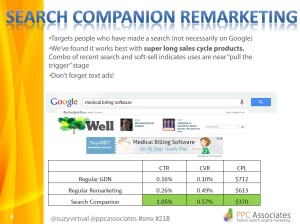Pro-level Tips To Succeed At Retargeting
One of the popular PPC sessions at SMX Advanced in Seattle was the Pro-level Tips to Succeeding at Retargeting. While many advertisers have plunged into the remarketing world via Google’s basic remarketing program, there are many varieties and programs available beyond Google. This session covered pro retargeting tips, Google remarketing programs, and explored non-Google channel […]
 One of the popular PPC sessions at SMX Advanced in Seattle was the Pro-level Tips to Succeeding at Retargeting. While many advertisers have plunged into the remarketing world via Google’s basic remarketing program, there are many varieties and programs available beyond Google. This session covered pro retargeting tips, Google remarketing programs, and explored non-Google channel retargeting opportunities.
One of the popular PPC sessions at SMX Advanced in Seattle was the Pro-level Tips to Succeeding at Retargeting. While many advertisers have plunged into the remarketing world via Google’s basic remarketing program, there are many varieties and programs available beyond Google. This session covered pro retargeting tips, Google remarketing programs, and explored non-Google channel retargeting opportunities.
Several of the offerings mentioned are still in beta, so getting access to them requires coordination with a Google Representative to get the offering turned on for your account.
The SMX Retargeting Tips panel was composed of Bryant Garvin of Get Found First, Jarvis Mak of Rocket Fuel, and Susan Waldes of PPC Associates, Moderated by Ginny Marvin of Search Engine Land. Here’s a summary of the highlights presented at the session.
Google’s Remarketing Lists for Search Ads (RLSA)
Essentially, remarketing works by letting advertisers define a remarketing list which is simply a set of criteria that identifies the segment of visitors to whom to serve ads. Google’s RLSA (which is in beta) gives advertisers a program for targeting based on a visitor’s behavior and allows advertisers to adjust their keywords, bids and ad based on a user’s past action on the advertiser’s website.
Susan Waldes presented a case study where she used RLSA for an ecommerce site. She ran a short purchase cycle ecommerce site over the holidays with a short time cookie of 7 days. The short cookie duration was due to the manic holiday season where the buying cycle is shortened. Her results using RLSA were impressive. The Cost per Acquisition (CPA) was cut in half and the conversion rate nearly quadrupled! Considering the holiday season can make or break many ecommerce sites, those results would put the crustiest Scrooge in good holiday spirits.
A subset of the Google’s remarketing is the exclusion lists. Susan encouraged the use of exclusions which allow advertisers to further segment and refine the audience. Some common uses of exclusions are to tag visitors who have already purchased or filled out a form so you don’t keep selling to the converted. Susan described a case study that demonstrated the value of exclusion lists. When she added an exclusion list of converted users, she was able to eliminate over 25% of unwanted costs and duplicate leads.
YouTube Remarketing
Remarketing on YouTube is a valuable way to turn YouTube into a “social channel” for collecting qualified user lists. Susan suggested promoting key videos in YouTube and to consider cross-channel efforts such as promoted tweets of videos to “feed” your list.
Search Companion Remarketing
Search companion remarketing (currently in Beta at Google) is when a user searches for a keyword query and then Google shows your ad on the page they select in the organic results (the page where the ad shows has to be on a website that allows Google ads).
The appeal of this program is the searcher does not have to go to your web site first. The searcher is tagged just by doing a search on Google. As the searcher visits other sites, your ad will show (again on the sites that participate in the Google Display Network).
In the case study testing Search Companion remarketing, Susan found her conversion rate went from .1% with regular Google Display network, to .49% with regular remarketing, to .57% with Search Companion remarketing.
Dynamic Remarketing
If product listing ads (PLAs) are working well for you, you should test out the dynamic remarketing program, another program that Google is currently offering in beta. Susan recommended that you contact Google for their assistance in implementing it. She warned the audience that the set up is difficult.
Fortunately, the results of the PLA dynamic remarketing program made the tough implementation worthwhile. In Susan’s test case for users who viewed a product page less than seven days ago, she had a 40% increase in CTR and 112% lift in conversion rate compared to regular remarketing.
The program was also extremely effective in recapturing users who had abandoned a shopping cart 15-30 days prior. In her case study, they had a 772% higher conversion rate—definitely a lucrative endeavor!
Similar Users Remarketing
Susan Waldes and Bryant Garvin presented case studies highlighting successes produced by using Similar Users Remarketing. This program provides a way for advertisers to target an audience who is looking for products and services your company offers, but haven’t yet visited your site. Because they are actively seeking your offerings, the results of this form of remarketing are promising.
Google Analytics Lists
To take advantage of Google Analytics lists it requires a one-time Google Analytics code update. This form of remarketing allows much more granularity of remarketing lists. For example, advertisers can tag visitors who have multiple conversions, orders over a certain dollar amount, by geography and even by site actions.
Facebook Retargeting
According to a 2012 comScore white paper entitled 2012 U.S. Digital Future in Focus, advertisers can access 25% of all Display Inventory through Facebook advertising. Speakers Bryant Garvin and Jarvis Mak both advocated Facebook retargeting as a cost effective channel for online advertising.
The Facebook Exchange service (FBX) officially opened their program in September 2012 with 16 partner companies. Reports during the closed beta program with the partners showed impressive results.
Recently Facebook has been reducing their ad inventory (they had swelled to 27 different ad units). They dropped the sponsored stories and announced on 13 June 2013 that they are ending sponsored search ads as well. Facebook will continue to have ads (the ads in the right column are still present), but they are attempting to streamline their ad offerings by eliminating some and consolidating others.
Diversity Is Stability
Bryant Garvin advocated using a variety of retargeting programs. While Google’s remarketing program is simple for most advertisers to start on, he encouraged not being dependent on one source of traffic. Some of the other retargeting programs advertisers might want to acquaint themselves with include Simplifi, AdRoll, Rocketfuel, Fetchback, Chango, Quantcast and Tradedoubler.
Bryant shared his findings from a survey he conducted that asked respondents about the retargeting channels they used in their online marketing. Surprisingly, he found over 40% of the respondents only used Google remarketing. The biggest reason respondents gave for not participating in other channels was the minimum budget for other retargeting channels was too high. Many of the retargeting programs outside of Google require a large minimum budget: $5K or $10K is common.
Final Pro Retargeting Tips
Since the session was billed as “pro tips,” speakers dropped a few good reminders for the most effective results in remarketing including:
- Develop your remarketing plan upfront. Take time to construct well thought out, segmented lists.
- Set and test impression caps (or risk being creepy).
- Use the audience exclusion or a “kill pixel” to not sell to the converted.
- Test your cookie lengths and make sure the length is appropriate for your goals.
- Craft the marketing message to the purpose, product and user. Customize it for the user—don’t just use a generic display ad. Plan the sequence the ads are shown to the person.
- Make sure your messaging is consistent – if you have an ad for a special sale; make sure you have consistent messaging on the web site.
Done properly search retargeting is an effective tool for the online marketer. It works well to keep your brand top of mind and gives you a second chance to re-engage the visitor who got away. If you’re not retargeting consider starting with Google’s remarketing and then expanding out to other channels.
Retargeting opportunities are growing every day as it moves more into social media. Twitter recently announced they will offer a retargeting plan similar to Facebook’s only the Twitter offering will consider browsing history (which may turn out to be a weighty indicator of user intent). As the regular PPC bidding auction gets more competitive, retargeting is an area that isn’t as saturated and where creative messaging and list building is rewarded. Set aside a budget and try it today.
Contributing authors are invited to create content for Search Engine Land and are chosen for their expertise and contribution to the search community. Our contributors work under the oversight of the editorial staff and contributions are checked for quality and relevance to our readers. The opinions they express are their own.
Related stories
New on Search Engine Land


